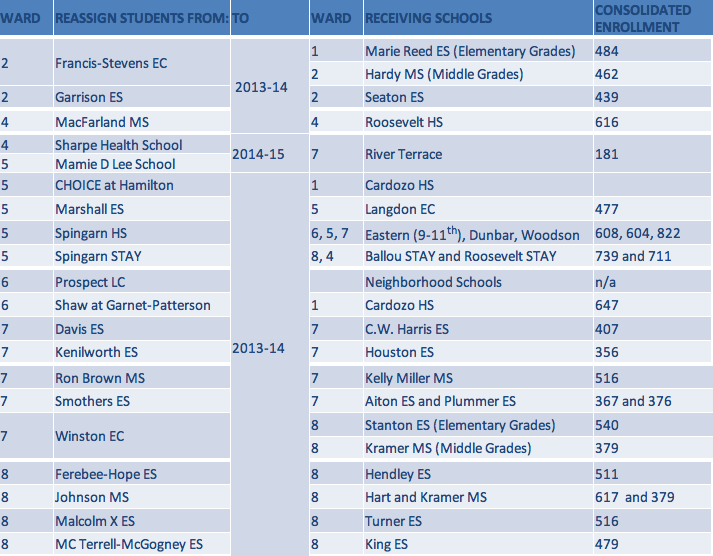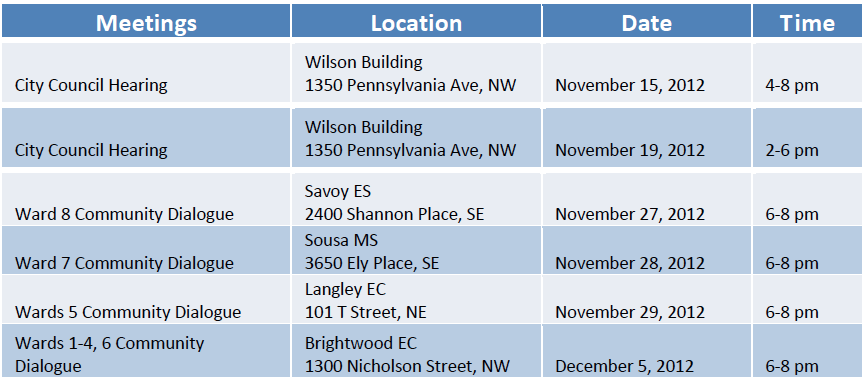DC Public Schools (DCPS) Chancellor Kaya Henderson today announced and requested public feedback on a proposal to consolidate 20 schools in six wards across the city. The list includes eight elementary schools, two education campuses, four middle schools, one high school, one STAY program, the CHOICE program and three special education campuses. Most school consolidations would go into effect for the 2013-2014 school year.
Challenges with Current Configuration of Schools:
“The challenge we face in DCPS is clear – our buildings are wildly under-enrolled, our resources are stretched too thin and we’re not providing the complement of academic supports that our students and families deserve,” said Henderson. “Consolidating schools is our best option to better utilize our facilities and work more efficiently for our schools, our teachers, our students and our city.”
Facilities: A priority for DCPS is ensuring as many students as possible are in modernized buildings. Since 2007, DCPS has modernized 45 of the current total of 117 school buildings. Taking into account buildings that were previously modernized, 57 schools – almost half of the school system inventory still await modernization. Even after an enormous, city-wide investment of over $1.3 billion since 2007, almost 20,000 students still attend schools that need modernization.
Funds: Overall, DCPS spends less in large and fully-enrolled schools than it does at small and under-enrolled schools. Because DCPS has many under-enrolled schools, DCPS invests in maintaining these schools when it makes more sense to invest more in programs to help low-performing students, increase opportunities for advanced learners, and develop specialized programs to better engage students.
Staffing: 45 percent, or nearly half of DCPS schools, have only one teacher per grade level, making shared planning time impossible and forcing teachers to work on lesson plans by themselves. With only one teacher per grade level, small changes in student populations at a specific grade can force larger class sizes. In addition, schools cannot provide flexible grouping to meet specific student needs (for example, small groups for struggling learners.)
Consolidation Plan:
“To achieve our goals of a great school for every single student, we have to use all of our resources well – every dollar, every building, and every minute of instructional time. As our schools are currently organized, we can’t achieve our goals,” said Henderson.
When making the proposed list, DCPS considered student enrollment and demographic trends in the community, building utilization rates, building condition and modernization status and the availability of receiving schools to offer students an improved education experience.
Consolidating these 20 schools will allow DCPS to offer a high-quality education to all students, use all resources more effectively, establish a flexible district that can account for future population growth and ensure the district’s long-term financial stability.
The portfolio of schools in DCPS will shift dramatically after these consolidations. The average school enrollment will increase to 432 students, up from 376. Overall building utilization rate will be 84 percent, an increase from 72 percent. Only 26 elementary schools will have fewer than 350 students, instead of 41. 1,700 additional students will have the opportunity to attend school in a modernized building.

Boundary and Feeder Patterns:
There are no proposed consolidations in Wards one and three. As part of the ongoing portfolio management process, DCPS has initiated a project aimed at updating boundaries and feeder patterns to more evenly distribute students. DCPS has engaged data experts to analyze population and enrollment data. Community engagement will begin this winter and continue through the spring of 2013. New boundaries and feeder patterns will not take effect until the 2014-2015 school year.
Community Engagement:
“This proposal is a conversation with our communities,” said Henderson. “We need to hear from families and community members. We are relying deeply on community feedback and engagement to ensure our success. We want to hear the innovative and creative ideas that come from our school communities to help make sure that our consolidation plan represents the best thinking of the city.”
DCPS will hold a variety of stakeholder meetings to get feedback on the proposed consolidations, including four scheduled ward-based meetings. In addition, DCPS officials will meet with ANC members, ward-based education councils and other community groups. The DCPS Office of Family and Public Engagement will host office hours in December to meet with other interested groups to ensure that all public concerns are accounted for as the school configuration plan is finalized. DCPS will also provide a platform for online feedback.

More information and materials are available here.
Contact: Melissa Salmanowitz | 202-535-1096


